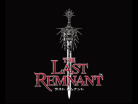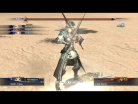- CLASSIC MAGAZINES
- REVIEW CREW
A show recapping what critics thought back
when classic games first came out! - NEXT GENERATION'S BEST & WORST
From the worst 1-star reviews to the best
5-stars can offer, this is Next Generation! - NINTENDO POWER (ARCHIVE)
Experience a variety of shows looking at the
often baffling history of Nintendo Power! - MAGAZINE RETROSPECTIVE
We're looking at the absolutely true history of
some of the most iconic game magazines ever! - SUPER PLAY'S TOP 600
The longest and most ambitious Super NES
countdown on the internet! - THEY SAID WHAT?
Debunking predictions and gossip found
in classic video game magazines! - NEXT GENERATION UNCOVERED
Cyril is back in this spin-off series, featuring the
cover critic review the art of Next Generation! - HARDCORE GAMER MAGAZING (PDF ISSUES)
Download all 36 issues of Hardcore Gamer
Magazine and relive the fun in PDF form!
- REVIEW CREW
- ELECTRONIC GAMING MONTHLY
- ELECTRONIC GAMING MONTHLY RANKS
From Mario to Sonic to Street Fighter, EGM
ranks classic game franchises and consoles! - ELECTRONIC GAMING MONTHLY BEST & WORST
Counting down EGM’s best and worst reviews
going year by year, from 1989 – 2009! - ELECTRONIC GAMING BEST & WORST AWARDS
11-part video series chronicling the ups and
downs of EGM’s Best & Worst Awards!
- ELECTRONIC GAMING MONTHLY RANKS
- GAME HISTORY
- GAME OVER: STORY BREAKDOWNS
Long-running series breaking down game
stories and analyzing their endings! - A BRIEF HISTORY OF GAMING w/ [NAME HERE]
Real history presented in a fun and pithy
format from a variety of game historians! - THE BLACK SHEEP
A series looking back at the black sheep
entries in popular game franchises! - INSTANT EXPERT
Everything you could possibly want to know
about a wide variety of gaming topics! - FREEZE FRAME
When something familiar happens in the games
industry, we're there to take a picture! - I'VE GOT YOUR NUMBER
Learn real video game history through a series
of number-themed episodes, starting at zero! - GREAT MOMENTS IN BAD ACTING
A joyous celebration of some of gaming's
absolute worst voice acting!
- GAME OVER: STORY BREAKDOWNS
- POPULAR SHOWS
- DG NEWS w/ LORNE RISELEY
Newsman Lorne Riseley hosts a regular
series looking at the hottest gaming news! - REVIEW REWIND
Cyril replays a game he reviewed 10+ years
ago to see if he got it right or wrong! - ON-RUNNING FEUDS
Defunct Games' longest-running show, with
editorials, observations and other fun oddities! - DEFUNCT GAMES QUIZ (ARCHIVE)
From online quizzes to game shows, we're
putting your video game knowledge to the test!- QUIZ: ONLINE PASS
Take a weekly quiz to see how well you know
the news and current gaming events! - QUIZ: KNOW THE GAME
One-on-one quiz show where contestants
find out if they actually know classic games! - QUIZ: THE LEADERBOARD
Can you guess the game based on the classic
review? Find out with The Leaderboard!
- QUIZ: ONLINE PASS
- DEFUNCT GAMES VS.
Cyril and the Defunct Games staff isn't afraid
to choose their favorite games and more! - CYRIL READS WORLDS OF POWER
Defunct Games recreates classic game
novelizations through the audio book format!
- DG NEWS w/ LORNE RISELEY
- COMEDY
- GAME EXPECTANCY
How long will your favorite hero live? We crunch
the numbers in this series about dying! - VIDEO GAME ADVICE
Famous game characters answer real personal
advice questions with a humorous slant! - FAKE GAMES: GUERILLA SCRAPBOOK
A long-running series about fake games and
the people who love them (covers included)! - WORST GAME EVER
A contest that attempts to create the worst
video game ever made, complete with covers! - LEVEL 1 STORIES
Literature based on the first stages of some
of your favorite classic video games! - THE COVER CRITIC
One of Defunct Games' earliest shows, Cover
Critic digs up some of the worst box art ever! - COMMERCIAL BREAK
Take a trip through some of the best and
worst video game advertisements of all time! - COMIC BOOK MODS
You've never seen comics like this before.
A curious mix of rewritten video game comics!
- GAME EXPECTANCY
- SERIES ARCHIVE
- NINTENDO SWITCH ONLINE ARCHIVE
A regularly-updated list of every Nintendo
Switch Online release, plus links to review! - PLAYSTATION PLUS CLASSIC ARCHIVE
A comprehensive list of every PlayStation
Plus classic release, including links! - RETRO-BIT PUBLISHING ARCHIVE
A regularly-updated list of every Retro-Bit
game released! - REVIEW MARATHONS w/ ADAM WALLACE
Join critic Adam Wallace as he takes us on a
classic review marathon with different themes!- DEFUNCT GAMES GOLF CLUB
Adam Wallace takes to the links to slice his way
through 72 classic golf game reviews! - 007 IN PIXELS
Adam Wallace takes on the world's greatest spy
as he reviews 15 weeks of James Bond games! - A SALUTE TO VAMPIRES
Adam Wallace is sinking his teeth into a series
covering Castlevania, BloodRayne and more! - CAPCOM'S CURSE
Adam Wallace is celebrating 13 days of Halloween
with a line-up of Capcom's scariest games! - THE FALL OF SUPERMAN
Adam Wallace is a man of steel for playing
some of the absolute worst Superman games! - THE 31 GAMES OF HALLOWEEN
Adam Wallace spends every day of October afraid
as he reviews some of the scariest games ever! - 12 WEEKS OF STAR TREK
Adam Wallace boldly goes where no critic has
gone before in this Star Trek marathon!
- DEFUNCT GAMES GOLF CLUB
- DAYS OF CHRISTMAS (ARCHIVE)
Annual holiday series with themed-episodes
that date all the way back to 2001!- 2015: 30 Ridiculous Retro Rumors
- 2014: 29 Magazines of Christmas
- 2013: 29 Questionable Power-Ups of Christmas
- 2012: 34 Theme Songs of Christmas
- 2011: 32 Game Endings of Christmas
- 2010: 31 Bonus Levels of Christmas
- 2009: 30 Genres of Christmas
- 2008: 29 Controls of Christmas
- 2007: 34 Cliches of Christmas
- 2006: 33 Consoles of Christmas
- 2005: 32 Articles of Christmas
- 2004: 31 Websites of Christmas
- 2003: 29 Issues of Christmas
- 2002: 28 Years of Christmas
- 2001: 33 Days of Christmas
- NINTENDO SWITCH ONLINE ARCHIVE
- REVIEW ARCHIVE
- FULL ARCHIVE
The Last Remnant
I won't lie to you; the first ten hours of The Last Remnant are rough. As I trudged through what felt like endless battles full of lame bad guys and ridiculous heroes, I wondered how Square Enix could have failed so miserably at delivering another great role-playing game. This is a company made up of two of the greatest storytellers of our time, and The Last Remnant was the best they could come up with? I felt doomed. To make matters worse I saw that second disc just taunting me, letting me know that this isn't going to be a short game. Thankfully I stuck with The Last Remnant, because what I found to annoying and tedious before became exciting and involving the further I got. It may not be Square Enix's best work, but The Last Remnant is different enough to warrant a look.
It's important to realize right from the get-go that The Last Remnant is not a game for everybody. For many the game's cliche story, forgettable cast and atrocious technical problems will turn them away from what is an otherwise solid game. This is not one of Square Enix's best efforts, I certainly realize that, but there are enough good ideas in this game to make me recommend it, even if it's only a tepid recommendation. For me there was a moment when the whole thing just clicked; I still disliked a lot of the elements, but enough of it worked to where I started to have a lot of fun. It's a shame that Square Enix made so many questionable design decisions along the way.
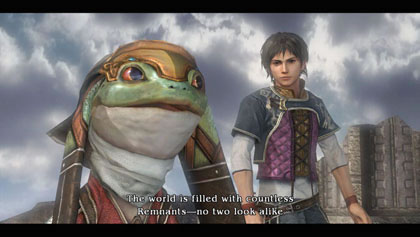
The Last Remnant starts out promising enough. You play Rush Sykes, a young boy who is doing whatever he can to track down his parents and rescue his kidnapped sister. The task sounds simple enough, but if you think this is going to be a straightforward mission then you clearly missed the part where I said this was on two DVDs. On his quest to rescue his sister he will meet all sorts of colorful characters, complete a whole bunch of different quests and ultimately get caught up in a political struggle to control these magical crystal-things named remnants. All this comes together in an interesting (albeit predictable) story that will take you all over the game's map, battling huge armies of ugly monsters and leveling yourself up.
While nothing about the story is especially new or innovative, the gameplay manages to mix together enough interesting ingredients to make something wonderful. The Last Remnant's combat system takes a lot from the turn-based gameplay of other classic Square Enix games (Final Fantasy, Chrono Trigger, etc.), but adds an interesting tactical RPG element that quickly becomes the most compelling reason to keep playing the game.
Instead of controlling individual characters, you are in charge of an entire union of characters. You choose which group of bad guys you want to attack, how you want to attack them and then start your battle. What sets this system apart is how the battles come together. For the most part you're orchestrating how you want your turn to play out before taking your turn, doing nothing more than telling the group where they need to go and what they need to do. However, when you see the battle take place it's like nothing else Square Enix has ever done. Even when you're only controlling one or two unions, you're still seeing a half dozen characters go at it in the middle of a gorgeous battlefield.
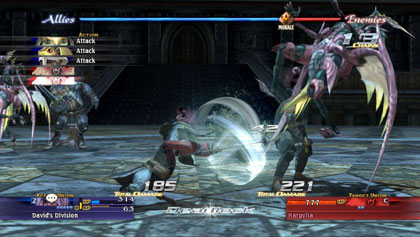
But there's an inherent problem with this interesting union vs. union combat mechanic. For starters, what makes this fun isn't immediately recognizable. Chances are you'll find yourself hating the combat until you're finally given the chance to control more than one grouping of units. By the end of the game you'll find yourself commanding dozens of characters, all battling these huge bosses and impressive armies. It's at this point that you realize how new and exciting this combat mechanic is, it just takes you the better part of ten hours before it hits you.
Sadly, in the ten hours before this game picks up steam you'll encounter literally dozens of good reasons to completely stop playing. In fact, there are so many problems with the game's first act that I fear I don't have enough space to go over all of them. We'll start with the most obvious problem - the game's horrific technical problems. I've played a lot of games in my years, but never have I seen a game with so many technical problems. For one thing, at no point does this game run smoothly. From the first seconds of the story you'll notice that there are non-stop frame rate problems, inconsistent textures, horrible clipping problems, rampant slowdowns and graphical pop-ups. And that's just what you'll notice in the first few seconds. From beginning to end, The Last Remnant is full of these issues, to the point where you just get used to textures popping at random times, or how just about everything requires a five second loading screen, or how it feels like the game is going to break down at any time. These are things that you just put up with, which is a real shame.
Another problem is the game's story, which starts slow and stays in neutral for far too long. Your protagonist doesn't help any, Rush is about as exciting as The Lawrence Welk Show. I can sympathize with his plight to get his sister back, but that's not exactly the most compelling plot point for an epic role-playing game. Eventually the game's story picks up and it's easy to get wrapped up in the high drama, but it takes entirely too long before you get to that point. Given how dull much of the early part of the story is I can understand how a lot of people will want to stop playing almost immediately.
Another problem is the graphic design, which is neither good nor bad. The game is built on the Unreal 3 Engine, and to Square Enix's credit they managed to make a game where everybody looks like a Gears of War reject. The problem is that there's nothing about the graphics style that stands out, it all feels very safe. Even though this is a brand new world full of new races, locations and monsters, I couldn't get over the feeling like I had been there before. The game's art style just isn't very original, and that's one of those things I had to fight to get over. I couldn't help but think that if this game had a more interesting art style people could look past the game's slow story and technical problems. But I guess we'll never know. All I can say is that for most of the time I yearned for a game that looked different, less uninspired.
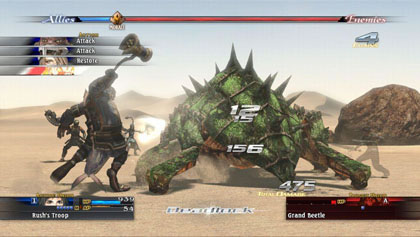
The good news is, once you get past the game's abysmal first act everything starts to click. The story starts to get interesting, you start to travel to more interesting locations, your battles are elaborate and impressive, and you finally get used to your protagonists complete lack of character. It's at this moment that the brilliance of the game comes shines through, which is why the more you play the easier it is to recommend. However, at the exact same time it's disappointing that it takes so long for the game's brilliance to show up. It's frustrating to think about how much potential is ultimately wasted in this good-but-not-great role-playing game.
Considering how many problems I have with this game, the very fact that I can wholeheartedly recommend this product speaks volumes about what the team got right. I won't kid you, there is a lot to hate in this game, but when the game is good it's absolutely golden. The big reason I kept coming back was because of the engaging battle system. Yes it's simple, yet the further you progress the more unexpected depth is found. By the time you're on the second disc you can't wait to get into battle. We're talking about epic battles that could take a good chunk of time to finish. In a lot of ways the battles play out like a cross between Advance Wars and Final Fantasy Tactics, only improved by the small dab of traditional RPG turn-based gameplay.
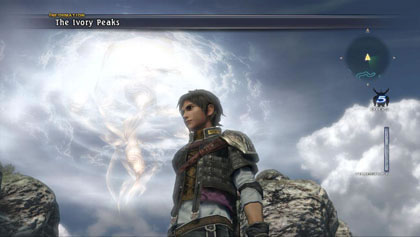
And best of all, you never have to worry about finding an inn to rest or using potions to replenish your magic points. In The Last Remnant your life and magic is instantly refilled the moment you leave a battle. That means that you'll always be fresh and ready when you enter a battle and then once you're done, you're off looking for another battle without worrying about fixing wounds. This smart decision helps keep the action flowing instead of being bogged down by useless micromanaging. This is the kind of thing I would like to see in more modern role-playing games. It may be a little thing but it certainly helped keep me engaged and it ultimately made this game feel different from the rest of the Final Fantasy clones on the market.
When everything is said and done The Last Remnant will probably be remembered as a minor game from Square Enix, easily forgotten once the new Final Fantasy and Dragon Quest hit store shelves. But The Last Remnant is a solid role-playing game that is unfortunately marred by a slow moving story, lame characters and some of the worst performance issues I have ever run across. There's a fun game to be found here, but you're going to have to do a lot of digging. Hopefully in the near future Square Enix can take this concept, add a different art design, fix the technical problems and turn it into the must-own game it deserves to be.
HOME |
CONTACT |
NOW HIRING |
WHAT IS DEFUNCT GAMES? |
NINTENDO SWITCH ONLINE |
RETRO-BIT PUBLISHING
Retro-Bit |
Switch Planet |
The Halcyon Show |
Same Name, Different Game |
Dragnix |
Press the Buttons
Game Zone Online | Hardcore Gamer | The Dreamcast Junkyard | Video Game Blogger
Dr Strife | Games For Lunch | Mondo Cool Cast | Boxed Pixels | Sega CD Universe | Gaming Trend
Game Zone Online | Hardcore Gamer | The Dreamcast Junkyard | Video Game Blogger
Dr Strife | Games For Lunch | Mondo Cool Cast | Boxed Pixels | Sega CD Universe | Gaming Trend
Copyright © 2001-2025 Defunct Games
All rights reserved. All trademarks are properties of their respective owners.
All rights reserved. All trademarks are properties of their respective owners.







